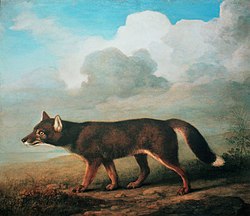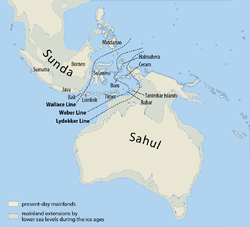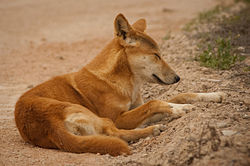Dingo
The dingo is a wild dog from Australia. They are not found in Tasmania, where the sea levels cut the island off from mainland Australia about 10,000 years ago.[1]
| Dingo | |
|---|---|

| |
| A male dingo | |
| Conservation status | |
| Scientific classification | |
| Kingdom: | Animalia |
| Phylum: | Chordata |
| Order: | Carnivora |
| Family: | Canidae |
| Genus: | Canis |
| Species: | |
| Subspecies: | C. l. dingo
|
| Trinomial name | |
| Canis lupus dingo Meyer, 1793
| |

| |
| Distribution of dingoes and hybrids | |
| Synonyms | |
|
Canis dingo Meyer, 1793 | |
The earliest known dingo remains were found in Western Australia. It dates to 3,450 years ago. However, the genes show that the dingo reached Australia 8,300 years ago. The humans which brought them are unknown. Dingo morphology has not changed over the past 3,500 years: this suggests that artificial selection has not been done over this period.[2]
Their scientific name, Canis lupus (wolf) dingo, was changed recently from Canis familiaris (dog) dingo.[3] This was to show it is related to the white footed wolf which lives in Asia.
Description
Dingos (or Dingoes) are usually between 117 cm to 124 cm in length. Their tail is about 30 cm in length. They usually weigh between 10 kg and 20 kg. The colour of their fur is usually yellow-ginger, but can sometimes include tan, black, white or sandy colours. They live for about 14 years.
Dingos live in packs of between 3 and 12, but they can be seen alone as well. The leaders are the alpha male and the alpha female and are usually the only pair to breed. Young dingos are called "cubs". The breeding season is in March and April. After a gestation of 63 days, the adult females usually give birth to 4-5 cubs in a litter.[4] Mothers will regurgitate food for the cubs to eat.[5] They become independent of their mother after four to eight months of age.
Dingos do not bark like other dogs, but they do howl.[5]
Diet
Dingos are carnivores and eat other animals such as kangaroos, wallabies, wallaroos, Emus, rabbits, rodents, lizards, sheep, calves, poultry and carrion. It is believed to have hunted several animal species to extinction including some species of bandicoots and rat kangaroos. They often hunt in packs.
Managing dingos
While some people keep dingos as pets, they are regarded as a pest by farmers. They are controlled by trapping, shooting, poisoning (with sodium monofluoroacetate), and fences.[3] The dingo fence which runs through South Australia, and then along the New South Wales border through to central Queensland is the world's longest fence.[3] Dingos are protected in national parks and reserves.
It is illegal to have a dingo as a pet in South Australia, Queensland, and Tasmania. In Victoria and the Northern Territory, you have to have a special permit to keep a dingo.[6] The dingo can be a dangerous animal: they have attacked people at times. On April 30, 2001, a nine-year-old boy was attacked and killed on Fraser Island by a dingo.[7] A dingo is believed to have killed a baby, Azaria Chamberlain, at Uluru in August, 1980.[8] This became a world famous case when her mother was sent to jail for murdering the baby. She was later found innocent and released. Evil Angels, a book about Azaria by John Bryson, was made into a movie starring Meryl Streep.
Dingo Media
Dingo on the beach at K'gari, Queensland
"Dog of New South Wales" illustrated in The Voyage of Governor Phillip to Botany Bay in 1788
The Sahul Shelf and the Sunda Shelf during the past 12,000 years: Tasmania separated from the mainland 12,000 YBP, and New Guinea separated from the mainland 6,500–8,500 YBP.
Dingo on the Nullarbor Plain
References
- ↑ Jackson, Stephen; Groves, Colin 2015. Taxonomy of Australian mammals. CSIRO Publishing, Clayton, Victoria, Australia. pp. 287–290. ISBN 978-1-4863-0013-6
- ↑ Smith, Bradley P.; Cairns, Kylie M.; Adams, Justin W.; Newsome, Thomas M.; Fillios, Melanie; Déaux, Eloïse C.; Parr, William C.H.; Letnic, Mike; Van Eeden, Lily M.; Appleby, Robert G.; Bradshaw, Corey J. A.; Savolainen, Peter; Ritchie, Euan G.; Nimmo, Dale G.; Archer-Lean, Clare; Greenville, Aaron C; Dickman, Christopher R.; Watson, Lyn; Moseby, Katherine E.; Doherty, Tim H.; Wallach, Adrian D.; Morrant, Damian S.; Crowther, Mathew S. 2019. Taxonomic status of the Australian dingo: the case for Canis dingo Meyer, 1793. Zootaxa 4564 (1): 173–197.
- ↑ 3.0 3.1 3.2 "The Dingo". Native Animal Fact Sheets. Department of Environment, Climate Change and Water. Archived from the original on 2009-07-06. Retrieved 2009-11-14.
- ↑ Smith, Bradley ed. 2015. The dingo debate: origins, behaviour and conservation. CSIRO Publishing, Melbourne, Australia. ISBN 978-1-4863-0030-3
- ↑ 5.0 5.1 "Australian Dingo". Archived from the original on 2009-12-18. Retrieved 2009-11-14.
- ↑ "Dingoes". Creature Features. ABC. 2009. Retrieved 2009-11-14.
- ↑ Sinclair, John (May 2, 2001). "Dingos of Fraser Island". Retrieved 2009-11-15.
- ↑ Marks, Kathy (6 May 2001). "Fear of the dingo returns to Australia in wake of boy's death". The Independent. Archived from the original on 2011-03-26. Retrieved 2009-11-15.









